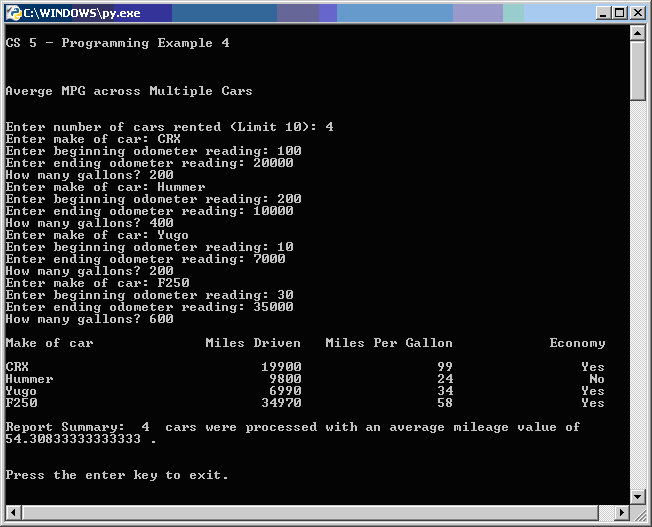- Click this link to see the PythonTutorialFour.python starter file
- Copy the contents into notepad
- Save the notepad file using the name PythonTutorialFour.py on to your student disk
- Open the file using the notepad application (TextEdit if you are on a Mac)
- Your file should look something like this ---->

-
Enter the code shown below after the comment that says "Initialize Variables"
carType = [0,0,0,0,0,0,0,0,0,0] # Holds the Car Types
startMiles = [0,0,0,0,0,0,0,0,0,0] # Holds the starting odometer readings
endMiles = [0,0,0,0,0,0,0,0,0,0] # Holds the ending odometer readings
gallonsUsed = [0,0,0,0,0,0,0,0,0,0] # Holds the number of gallons used
totalMiles = [0,0,0,0,0,0,0,0,0,0] # Holds the total miles driven
milesPerGallon = [0,0,0,0,0,0,0,0,0,0] # Holds the miles per gallon
carMessage = [0,0,0,0,0,0,0,0,0,0] # Holds the economy designation
carIndex = 0 # Holds the counter for the "for" loop
mpgAccumulator = 0 # Holds the total mpg for all cars
averageMPG = 0 # Holds the average mpg for all cars
carsRented = 0 # Holds the number of cars rented
Notice that we have taken a new approach in storing variables here. We are using something called an Array (or list in Python). Not only does it allow us to store several pieces of like information together, we can use the loop index variable to help us store in a structured grid.
-
Enter the code shown below after the comment that says "Print a title for the report"
print("\n Your Name - CS 5 - Programming Example 4") # The \n is a new line
print("\n")
print("\n Average MPG across multiple cars")
print("\n")
-
Enter the code shown below after the comment that says "Get User Input Data"
carType[carIndex] = input("Enter make of car: ")
startMiles[carIndex] = int(input("Enter beginning odometer reading: "))
endMiles[carIndex] = int(input("Enter ending odometer reading: "))
gallonsUsed[carIndex] = float(input("How many gallons? "))
-
Enter the code shown below after the comment that says "Compute Calculated Values"
totalMiles[carIndex] = endMiles[carIndex] - startMiles[carIndex]
milesPerGallon[carIndex] = totalMiles[carIndex] / gallonsUsed[carIndex]
mpgAccumulator = mpgAccumulator + milesPerGallon[carIndex]
if milesPerGallon[carIndex] > 30:
carMessage[carIndex] = "Yes"
else:
carMessage[carIndex] = "No"
-
Enter the code shown below after the comment that says "Print Column Headings"
print()
print("%-18s" % "Make of Car: " , end=" ")
print("%18s" % "Miles Driven: " , end=" ")
print("%18s" % "Miles Per Gallon: " , end=" ")
print("%18s" % "Ecomony: ")
print()
-
Enter the code shown below after the comment that says "Print Detail Lines"
print("%-18s" % carType[carIndex] , end=" ")
print("%18d" % totalMiles[carIndex] , end=" ")
print("%18d" % milesPerGallon[carIndex] , end=" ")
print("%18s" % carMessage[carIndex])
-
Enter the code shown below after the comment that says "Print Summary Reports"
print()
averageMPG =mpgAccumulator / carsRented
print("Report Summary: " ,carsRented," cars were processed with an average mileage value of")
print(averageMPG, ".")
- Save your program to your student disk. Change the name of the program so you know this is the completed version. Note: Be sure the name ends with ".py" - this is what lets the Python Interpreter identify and run your program.
